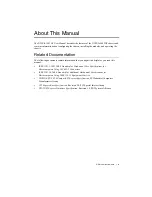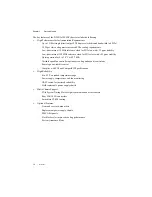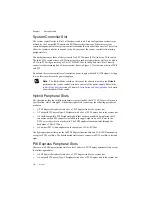
© National Instruments
|
1-11
A copy of the backplane’s PXI_CLK10 is exported to the 10 MHz REF OUT connector on the
rear of the chassis. Refer to Figure 1-2 for the location of this connector. This clock is driven by
an independent buffer. Refer to Appendix A,
, for the specification information for
the 10 MHz REF OUT signal on the rear panel of the chassis.
PXIe_SYNC_CTRL
PXIe_SYNC100 is by default a 10 ns pulse synchronous to PXI_CLK10. The frequency of
PXIe_SYNC100 is 10/
n
MHz, where
n
is a positive integer. The default for
n
is 1, giving
PXIe_SYNC100 a 100 ns period. However, the backplane allows
n
to be programmed to other
integers. For instance, setting
n
= 3 gives a PXIe_SYNC100 with a 300ns period while still
maintaining its phase relationship to PXI_CLK10. The value for
n
may be set to any positive
integer from 1 to 255.
The system timing slot has a control pin for PXIe_SYNC100 called PXIe_SYNC_CTRL for use
when
n
> 1. Refer to Table B-6,
XP3 Connector Pinout for the System Timing Slot
, for system
timing slot pinout. Refer to Appendix A,
, for the PXIe_SYNC_CTRL input
specifications.
By default, a high-level detected by the backplane on the PXIe_SYNC_CTRL pin causes a
synchronous restart for the PXIe_SYNC100 signal. On the next PXI_CLK10 edge the
PXIe_SYNC100 signal will restart. This will allow several chassis to have their
PXIe_SYNC100 in phase with each other. Refer to Figure 1-7 for timing details with this
method.
Figure 1-7.
PXIe_SYNC100 at 3.33 MHz Using PXIe_SYNC_CTRL as Restart
10 MHz clock present
No clock present
PXI_CLK10, PXIe_CLK100 and
PXIe_SYNC100 all phase-locked to
System Timing Slot—PXI_CLK10_IN
10 MHz clock present
10 MHz clock present
PXI_CLK10, PXIe_CLK100 and
PXIe_SYNC100 all phase-locked to
System Timing Slot—PXI_CLK10_IN
Table 1-1.
Backplane External Clock Input Truth Table (Continued)
System Timing Slot
PXI_CLK10_IN
Rear Chassis Panel
10 MHz REF IN
Backplane PXI_CLK10,
PXIe_CLK100 and PXIe_SYNC100
PXI_CLK10
PXIe_
S
YNC_CTRL
PXIe_
S
YNC100
S
YNC100 Divider
Re
s
t
a
rted Here




































